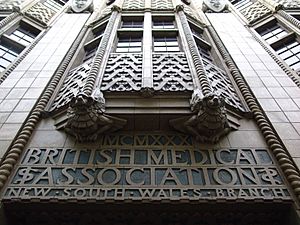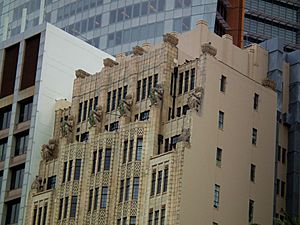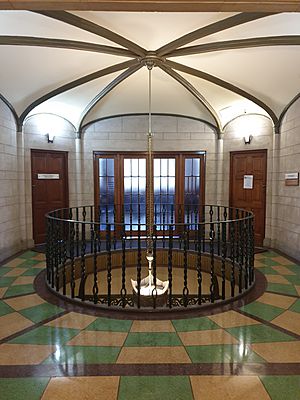AMA House, Sydney facts for kids
Quick facts for kids AMA House |
|
|---|---|

The façade of the AMA House building, pictured in 2007
|
|
| Location | 135-137 Macquarie Street, Sydney central business district, City of Sydney, New South Wales, Australia |
| Built | 1929–1930 |
| Architect | Fowell & McConnel |
| Architectural style(s) | Inter-war Art Deco |
| Owner | Strata Plan No.14172 |
| Official name: BMA House; AMA House; Australian Medical Association House | |
| Type | State heritage (built) |
| Designated | 2 April 1999 |
| Reference no. | 252 |
| Type | Commercial Office/Building |
| Category | Commercial |
| Builders | Messrs Hutcherson Bros |
| Lua error in Module:Location_map at line 420: attempt to index field 'wikibase' (a nil value). | |
AMA House, Sydney, also known as the Australian Medical Association House, is a historic building in Sydney, Australia. It was once a medical office and library. Today, it holds commercial offices. You can find it at 135-137 Macquarie Street in the heart of Sydney's business area.
The building was designed by Fowell & McConnel. It was built between 1929 and 1930 by Hutcherson Bros. It was first known as BMA House or the British Medical Association House. This special building is privately owned. It was added to the New South Wales State Heritage Register on April 2, 1999. This means it is protected for its historical and architectural importance.
Contents
A Look Back: The History of AMA House
How Did the British Medical Association Start?
The British Medical Association (BMA) began in England in 1832. Its main goals were to encourage the study of medicine and to support doctors. In 1879-80, the BMA opened branches in three Australian states. The New South Wales branch, led by Sir Arthur Renwick, started small in 1880. It quickly grew to be the largest BMA branch in Australia. This BMA branch took the place of an earlier group called the Australian Medical Association. That group was formed in Sydney in 1859 by Dr. William Bland.
Building the New Headquarters
The BMA in New South Wales grew a lot between 1908 and 1931. This was when Dr. Robert Todd was its secretary. Dr. Todd was a well-known doctor, lawyer, musician, and university teacher. He was very important in getting the land for the new building in the 1920s. This land on Macquarie Street used to be part of the First Government House grounds. Those grounds were divided up after the house was taken down in 1845-46.
The BMA bought two older houses at 135 and 137 Macquarie Street. These houses were taken down in 1929. The BMA then held a competition to choose an architect for their new building. Fowell and McConnel won the competition. Their builders, Hutcherson Bros, were hired to construct a tall, impressive building on the site.
A Modern Skyscraper for Sydney
The new BMA House was finished in April 1930. People praised it as one of the first buildings in Sydney that truly looked like a modern American "skyscraper." In 1933, its architects, Fowell and McConnel, won the first-ever Street medal and diploma from the Royal Institute of British Architects. This showed how special their design was.
The outside of the building has special glazed terracotta panels. These were made by a company called Wunderlich. This company also made the six full-size medieval knights in armor. You can see these knights, along with two Koalas, high up on the front of the building. Inside, the main meeting hall was decorated with Queensland maple wood. It also had special panels for good sound and insulation. Dr. Todd passed away just one year after the building was finished. The hall was then named the Robert H. Todd Assembly Hall in his honor.
The BMA's offices and library were on the first floor. Today, the building is mainly rented out to doctors and dentists.
From BMA to AMA
In 1972, the British Medical Association (BMA) changed its name to the Australian Medical Association (AMA). In the 1980s, the AMA moved to a new building in St Leonards. However, the original building on Macquarie Street is still known as AMA House. It continues to be used by medical professionals.
What Does AMA House Look Like?

The outside of AMA House is covered in shiny glazed terracotta tiles. It also has steel-framed windows. The building is made with a strong steel frame and rendered masonry (a type of brickwork covered with a smooth finish).
How Well Is It Preserved?
The building is in good condition. The special terracotta panels on the outside were made locally by Wunderlich. The building won an award for its street design in 1935. This shows how well-built and designed it was.
Why Is AMA House Important?
AMA House is a very special building in Sydney. It is listed on the New South Wales State Heritage Register. This means it is protected because of its unique history and design.
A Unique Architectural Style
AMA House is a great example of an early Sydney "skyscraper." It was built in the Inter-war Art Deco style. This style is known for its bold shapes and decorations. The building also has "Medieval" and "Gothic" touches. It shows how much American building styles influenced Sydney's buildings between the two World Wars.
What makes AMA House stand out is its use of local materials. This includes the special terracotta cladding by Wunderlich. It also features beautiful maple wood inside. The building is also famous for using Australian symbols in its design. Look closely, and you'll see Koala bears at the very top of the front! The building still has many of its original features, both inside and out. This makes its architectural importance even greater.
AMA House is also important because it was designed by a famous Sydney architecture firm, Fowell and McConnel. This was one of only two office buildings they designed during that time.
Connecting to Medical History
The building has strong ties to the medical profession in New South Wales. It was the home of the British Medical Association, which later became the Australian Medical Association (AMA). Even today, the building's name, special plaques, and decorations remind us of this history. Rooms like the Robert H. Todd Assembly Hall and the former AMA offices keep this connection alive. Its location on Macquarie Street is also important. This street was once known as a "medical precinct" (an area with many medical offices). AMA House is one of the clearest reminders of that past.
Advanced Building Techniques
The building is also important for its use of new materials and building techniques from the Interwar period. It shows how commercial "skyscrapers" were being built at that time. Many of these original features are still in place. It's also rare because it included squash courts on the roof when it was first built!
AMA House was added to the New South Wales State Heritage Register on April 2, 1999. This was because it met several important criteria:
- It shows the history of New South Wales: AMA House has important links to the medical profession in NSW. It was the home of the AMA, and its design includes symbols and rooms that tell this story. Its location on Macquarie Street also reminds us of the area's medical past.
- It shows great design and creativity: The building is a beautiful and rare example of an Art Deco "skyscraper" from its time. It has unique "Medieval" and "Gothic" decorations. It also uses local materials and Australian symbols like the koalas. The building's original design and details are still largely intact. It won an award for its design. It also has unusual features like special panels to help with air circulation before air conditioning was common.
- It is a rare example: This building is one of a kind. It is a highly decorated Art Deco "skyscraper" from the Interwar period. Its use of Australian symbols on the main front is unique.
- It represents a type of place: AMA House is a great example of the architectural styles, building methods, and materials used in tall commercial buildings during the Interwar period. It also shows the influence of American designs.
See Also
- List of heritage-listed buildings in Sydney


